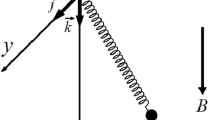Abstract
In order to analyze the motion characteristics of the spring pendulum under the action of magnetic field force, the motion of the spring pendulum will be studied by applying a uniform magnetic field in the vertical direction. Firstly, a first-order approximate solution is given by studying the micro-vibration around its equilibrium point. And an approximate solution similar to the Foucault pendulum is also presented in the case of a soft spring with strong ductility. Then, according to the resonance conditions of mechanical vibration, the internal resonance phenomenon of magnetic spring pendulum is discovered, and then the conclusion that the energy of the system is cyclically transmitted between the three modes of breathing, oscillating and deflection is presented subsequently. Finally, the influence of magnetic field strength on the motion stability of the spring pendulum is explored, and not only the bifurcation phenomenon at its equilibrium point is found, but also the complex dynamic behavior including chaotic motion occurs.













Similar content being viewed by others
Data Availability
All data generated or analyzed during this study are included in this published article.
References
Zhang, P., Li, H.N., Tian, L., Zhang, Z.Q.: Seismic vibration control of transmission tower with a spring pendulum. WEE 32(01), 210–218 (2016)
Wang, Q., Li, H.N., Zhang, P.: Calculation model of impact vibration reducing system of spring pendulum. J. Shenyang Jianzhu U: Nat. Sci. Ed. 34(02), 222–228 (2018)
Vitt, A., Gorelik, G.: Oscillations of an elastic pendulum as an example of the oscillations of two parametrically coupled linear systems. Tech Phys. 3(2–3), 294–307 (1933)
Broucke, R., Baxa, P.A.: Periodic solutions of a spring-pendulum system. Celest. Mech. Dyn. Astr. 8(2), 261–267 (1973)
Aldoshin, G.T., Yakovlev, S.P.: On swinging spring chaotic oscillations. In: AIP Conference Proceedings, vol. 1, p. 030001. AIP Publishing LLC, Melville (2018)
Awrejcewicz, J., Starosta, R., Sypniewska-Kamiska, G.: Stationary and transient resonant response of a spring pendulum. Procedia IUTAM 19, 201–208 (2016)
Olsson, M.G.: Why does a mass on a spring sometimes misbehave. Am. J. Phys. 44(12), 1211–1212 (1976)
Amer, T.S., Bek, M.A., Hamada, I.S.: On the motion of harmonically excited spring pendulum in elliptic path near resonances. Adv. Math. Phys. 2016, 1–15 (2016)
Gonzalez-Buelga, A., Kyrychko, Y., Wagg, D.J.: Bifurcations on a spring-pendulum oscillator. PAMM 7(1), 1030303–1030304 (2007)
Boeck, T., Sanjari, S.L., Becker, T.: Dynamics of a magnetic pendulum in the presence of an oscillating conducting plate. PAMM 20(1), e202000083 (2021)
Kitio Kwuimy, C.A., Nataraj, C., Belhaq, M.: Chaos in a magnetic pendulum subjected to tilted excitation and parametric damping. Math. Probl. Eng. 10, 1239–1257 (2012)
Mann, B.P.: Energy criterion for potential well escapes in a bistable magnetic pendulum. J. Sound Vib. 323(3–5), 864–876 (2009)
Qin, B., Shang, H.L., Jiang, H.M.: Global dynamic behavior analysis of typical magnetic pendulum. Acta Phys. Sin. 70(18), 180501 (2021)
Pili, U.B.: Modeling damped oscillations of a simple pendulum due to magnetic braking. Phys. Educ. 55(3), 035025 (2020)
Goldstein, H., Poole, C., Safko, J.: Classical Mechanics, 3rd edn. Pearson, Upper Saddle River (2002)
Greiner, W.: Classical Mechanics: Systems of Particles and Hamiltonian Dynamics, 2nd edn., pp. 26–27. Springer, New York (2003)
Frenkel, D., Portugal, R.: Algebraic methods to compute Mathieu functions. J. Phys. A-Math. Gen. 34(17), 3541 (2001)
Gutiérrez-Vega, J.C., Rodríguez-Dagnino, R.M., Meneses-Nava, M.A., Chávez-Cerda, S.: Mathieu functions, a visual approach. Am. J. Phys. 71(3), 233–242 (2003)
Acar, G., Feeny, B.F.: Floquet-based analysis of general responses of the Mathieu equation. J. Vib. Acoust. 138(4), 041017.1-041017.9 (2016)
Lawrence, R.: Applications of the Mathieu equation. Am. J. Phys. 64(1), 39–44 (1996)
Ramakrishnan, V., Feeny, B.F.: Resonances of a forced Mathieu equation with reference to wind turbine blades. J. Vib. Acoust. 134(6), 064501.1-064501.5 (2012)
Schulz-DuBois, E.O.: Foucault pendulum experiment by kamerlingh onnes and degenerate perturbation theory. Am. J. Phys. 38(2), 173–188 (1970)
Opat, G.I.: The precession of a Foucault pendulum viewed as a beat phenomenon of a conical pendulum subject to a Coriolis force. Am. J. Phys. 59(9), 822–823 (1991)
Pan, L.Y.: On rose curve and its application. C.A.S. 10, 236–238 (2008)
Xia, H.Y., Dai, J.P., Zhao, C.: The trajectory property analysis of inner cycloid. M.E.E.T. 46(01), 25–30 (2017)
Wolf, A., Swift, J.B., Swinney, H.L., et al.: Determining Lyapunov exponents from a time series. Phys. D. 16(3), 285–317 (1985)
Author information
Authors and Affiliations
Corresponding author
Ethics declarations
Conflict of interest
The author declares that he has no conflicts of interest to report regarding the present study.
Additional information
Publisher's Note
Springer Nature remains neutral with regard to jurisdictional claims in published maps and institutional affiliations.
Rights and permissions
Springer Nature or its licensor (e.g. a society or other partner) holds exclusive rights to this article under a publishing agreement with the author(s) or other rightsholder(s); author self-archiving of the accepted manuscript version of this article is solely governed by the terms of such publishing agreement and applicable law.
About this article
Cite this article
Meng, Y. Motion analysis of magnetic spring pendulum. Nonlinear Dyn 111, 6111–6128 (2023). https://doi.org/10.1007/s11071-022-08171-2
Received:
Accepted:
Published:
Issue Date:
DOI: https://doi.org/10.1007/s11071-022-08171-2




